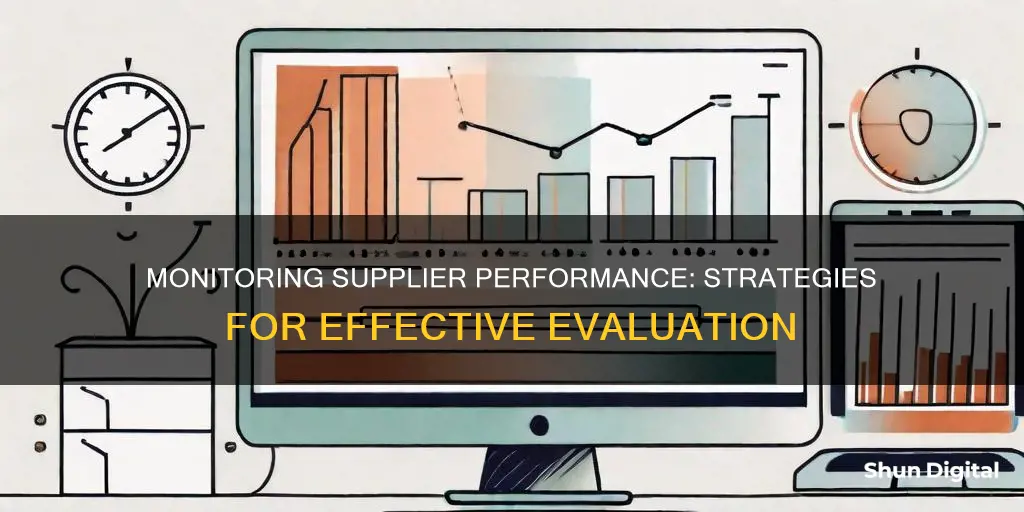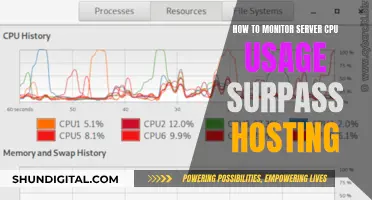
Supplier performance monitoring is a critical component of maintaining a resilient, efficient, and competitive supply chain. It involves tracking and evaluating suppliers' performance against agreed-upon standards and expectations, such as quality, cost, delivery, responsiveness, and compliance. This process is essential to ensure that businesses receive goods and services in a timely and cost-effective manner, meeting their operational needs and strategic goals. To facilitate this, organisations use various tools, including paper-based checklists, digital platforms, and performance management software, to collect and analyse data, providing a clear picture of supplier capabilities and areas for improvement.
| Characteristics | Values |
|---|---|
| Quality | Defect rates, product conformity, customer satisfaction |
| Cost | Cost per unit, total cost of ownership, scrap/rework costs |
| Delivery | On-time delivery, lead time, order fulfilment accuracy |
| Regulatory Compliance | Adherence to legal standards, health and safety protocols, and organisational guidelines |
| Social Responsibility | Sustainability, diversity, and community initiatives |
| Work Completed | Response time, work completed within a specified time period |
| Service Duration | Service completed for the expected duration or with the expected outcome |
| Rework | Low rework, errors, or complaints |
| Yield | Output, process efficiency |
| Utilization | Utilization, process efficiency, learning curve |
| Continuous Improvement | Resulting in improved outcomes |
What You'll Learn

On-time delivery
To ensure accurate evaluation of on-time delivery, it is crucial to define what it means for your business. OTD is typically calculated as the percentage of orders delivered on or before the promised date. However, the calculation method can vary depending on the agreed-upon parameters. For instance, the start date could be the date of order placement, confirmation, or shipment, while the end date could be the date of receipt, invoice, or payment. Additionally, a fixed or variable window, such as a specific number of days before or after the due date, can be considered.
When evaluating on-time delivery, several key metrics can be utilised:
- On-Time Delivery (OTD) Rate: This measures the percentage of orders delivered on or before the promised date. It is a crucial indicator of supplier performance and can be calculated by dividing the number of orders shipped on time by the total number of orders, multiplied by 100.
- Order Fill Rate: This assesses the supplier's ability to fulfil complete order quantities on the promised date. It is calculated by comparing the quantity ordered from the procurement department against the quantity received from the supplier.
- Late Delivery Rate: This metric tracks the percentage of orders delivered after the promised date. Monitoring this rate helps identify potential issues with delivery timelines.
- Lead Time Variance: This measures the variation between the promised and actual delivery dates. It helps gauge the consistency of delivery times and can be expressed in days or as a percentage.
- Customer Complaints: Monitoring customer feedback related to late deliveries provides qualitative insights into the supplier's performance.
To ensure effective monitoring of on-time delivery, it is essential to establish clear definitions, standards, and reporting methods. Communicating these expectations to suppliers and maintaining transparency are crucial for a successful supplier relationship. Additionally, it is beneficial to set benchmarks and targets for improvement, ensuring that suppliers consistently meet your on-time delivery expectations.
Monitoring Electricity Usage: Room-by-Room Power Insights
You may want to see also

Quality
Set Clear Quality Standards and Expectations
Clearly define the quality standards and KPIs that suppliers are expected to meet or exceed. These standards should be communicated transparently and endorsed by the suppliers. Quality metrics may include defect rates, product conformity, and customer satisfaction.
Regular Quality Assessments and Audits
Conduct regular quality assessments and audits to evaluate the quality of the goods or services provided by suppliers. This can be done through quality control reports, audits, or customer feedback surveys. By tracking quality metrics, you can identify any issues early on and address them promptly.
Feedback and Collaboration
Provide regular feedback to suppliers on their quality performance. Highlight areas where they meet or exceed expectations and discuss areas that need improvement. Open and transparent communication is crucial for effective supplier relationship management. Work collaboratively with suppliers to develop improvement plans and set timelines for achieving better quality.
Supplier Performance Management Software
Utilize supplier performance management software to track, measure, and assess supplier quality performance. These software tools can automate data collection and analysis, providing accurate and consistent tracking of quality metrics. They enable you to monitor quality in real time and receive alerts for any deviations from the expected quality standards.
Continuous Improvement
Foster a culture of continuous improvement by regularly reassessing quality standards and expectations. As your business needs evolve, you may need to adjust your quality metrics accordingly. Work closely with suppliers to enhance their capabilities and ensure they consistently meet your quality requirements.
Adjusting Monitor Size in Windows 10: A Simple Guide
You may want to see also

Cost
Key Performance Indicators (KPIs) are an essential aspect of supplier performance monitoring. When establishing KPIs related to cost, it is important to ensure they are specific, measurable, achievable, relevant, and time-bound (SMART). An example of a SMART KPI for cost could be "achieve a 5% reduction in supplier costs within the next fiscal year by negotiating better terms with suppliers and improving process efficiency."
Tracking supplier costs can be done manually through spreadsheets or automatically through software. Automated tracking tools can provide real-time data and alerts, enabling businesses to identify cost discrepancies and take timely action. Additionally, technology enables the aggregation of data from multiple suppliers, facilitating comparisons and informed decision-making.
Regular Cost Reviews
Conducting regular reviews of supplier costs is essential for effective cost management. These reviews should be conducted at agreed intervals, such as monthly, quarterly, or annually. During these reviews, businesses should assess if the suppliers are meeting the established cost benchmarks and targets. If there are discrepancies or areas of improvement, businesses should provide feedback and work collaboratively with suppliers to address these issues.
Supplier Scorecards
Supplier scorecards are documents that track and monitor supplier performance, including cost. They can include metrics such as cost per unit and total cost of ownership. By regularly updating and reviewing supplier scorecards, businesses can identify cost trends and make data-driven decisions about their supplier relationships.
Negotiating Better Terms
Through effective supplier performance monitoring, businesses can identify opportunities to negotiate better terms with suppliers. For example, if a supplier consistently fails to meet delivery deadlines, the business may be able to negotiate lower costs to compensate for the delays. Regularly reviewing and renegotiating contracts can help ensure cost efficiency and optimise the bottom line.
LCD Monitors: Understanding Camera Display Technology
You may want to see also

Compliance
Regulatory Compliance
Contractual Compliance
Supplier performance monitoring also involves evaluating compliance with contractual agreements and service level agreements (SLAs). This includes assessing whether the supplier meets the agreed-upon delivery timelines, quality standards, and other specified criteria. By monitoring contractual compliance, businesses can identify potential issues and ensure that the supplier fulfils their obligations.
Internal Policies and Procedures
In addition to external regulations and contractual agreements, suppliers are also expected to comply with the buying organisation's internal policies and procedures. This may include health and safety protocols, organisational guidelines, and ethical standards. Monitoring this aspect of compliance ensures that the supplier aligns with the organisation's values and ethical standards, contributing to a positive supplier relationship.
Continuous Improvement
Data Collection and Analysis
To effectively monitor compliance, organisations should implement systems to collect and analyse relevant data. This may include utilising supplier scorecards, automated tracking systems, or regular reporting by suppliers. By aggregating data on compliance performance, organisations can identify trends, areas of improvement, and ensure consistent adherence to compliance standards.
Regular Performance Reviews and Audits
Conducting periodic performance reviews and audits is essential for compliance monitoring. These reviews should be conducted at agreed intervals, such as monthly, quarterly, or annually. During these reviews, organisations can assess whether suppliers are meeting compliance benchmarks and targets. Audits provide an opportunity to evaluate compliance in detail, identify potential risks, and ensure that any corrective actions are implemented effectively.
The Standard 24-Inch Monitor: How Big Is It Really?
You may want to see also

Continuous improvement
- Feedback and Collaboration: During this phase, it is important to provide clear and transparent feedback to suppliers. Open and honest communication is crucial. Work collaboratively with suppliers to identify areas of improvement and develop actionable plans. This collaborative approach ensures that suppliers are engaged in the process and take ownership of their performance.
- Adjusting KPIs and Targets: As business needs and market conditions evolve, it may be necessary to adjust KPIs and performance targets. Regularly review and update these metrics to ensure they remain aligned with the organisation's strategic goals and market demands. This dynamic approach allows for flexibility and adaptability in the supplier performance management process.
- Performance Enhancement: The continuous improvement phase should focus on specific actions and initiatives to enhance supplier performance. This may include providing additional resources, training, or support to suppliers. Work closely with suppliers to implement process improvements, adopt best practices, and drive innovation.
- Monitoring Progress: Establish mechanisms to continuously monitor the progress of suppliers against the improvement plans. Regular check-ins, performance dashboards, and data tracking tools can help track the progress and identify areas where further adjustments may be needed.
- Documentation and Record-Keeping: Maintain comprehensive records of all performance evaluations, improvement plans, and outcomes. This documentation is crucial for future reference, decision-making, and assessing the effectiveness of the supplier performance management process.
- Supplier Engagement: Foster a culture of continuous improvement by engaging suppliers and seeking their input. Encourage suppliers to take initiative and proactively suggest enhancements to their processes and performance. Recognise and reward high-performing suppliers to motivate them to maintain and exceed standards.
By embracing continuous improvement, organisations can optimise their supply chain, minimise disruptions, and drive mutual growth with their suppliers. This phase is an ongoing journey that requires proactive evaluation, collaboration, and a commitment to enhancing the supplier-buyer relationship.
Disassembling Your BenQ LCD Monitor: Step-by-Step Guide
You may want to see also
Frequently asked questions
Supplier performance is measured through a combination of quantitative and qualitative data points. This includes metrics such as quality, cost, delivery, responsiveness, and compliance.
There are various tools available, including paper-based checklists and digital solutions. Supplier performance management software is one such tool that can automate data collection and analysis, providing real-time insights into supplier performance.
Reviews can take place at regular intervals, such as monthly, quarterly, or annually. Periodic reviews help to identify trends and make informed decisions about targets.
Monitoring supplier performance helps to ensure that the business receives goods and services as expected, in terms of quality, timeliness, and cost-effectiveness. It also enables the identification of areas for improvement and the mitigation of potential supply chain risks.







